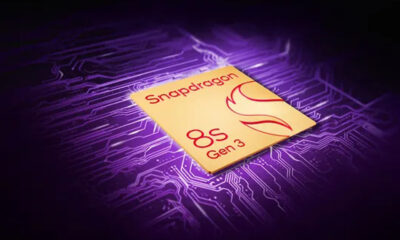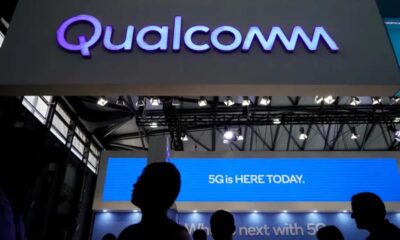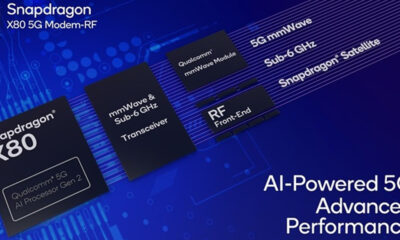News
Qualcomm Snapdragon 8 Gen 1 chip launched to power all 2022 flagships

Qualcomm has officially launched its next-generation flagship chipset for mobile phones called Snapdragon 8 Gen 1. With the announcement of this SoC, the chipmaker made radical changes in its product naming strategy as previous variants named triple-digit number which starts with 8.
Coming to its specifications, the Snapdragon 8 Gen 1 chip comes with Qualcomm’s latest and powerful technologies such as Qualcomm Artificial Intelligence (AI) Engine, which includes:
- AIE GPU: Qualcomm Adreno GPU
- Always-on AI: Qualcomm Sensing Hub
- AIE CPU: Qualcomm Kryo CPU
- Hexagon Processor: Fused AI Accelerator architecture, Qualcomm Hexagon Vector eXtensions (HVX), Qualcomm Hexagon Scalar Accelerator, Qualcomm Hexagon Tensor Accelerator
In terms of CPU, the Snapdragon 8 Gen 1 processor features CPU clock speed up to 3.0GHz, Qualcomm Kryo CPU cores, and 64-bit architecture. In addition, it is equipped with Snapdragon X65 5G Modem-RF System which brings peak download speed up to 10 Gbps.
- Cellular Modem-RF Specs: 8 carriers (mmWave), 2×2 MIMO (mmWave), 4×4 MIMO (Sub-6)
Heading to the camera capabilities, the Snapdragon 8 Gen 1 chip has a Qualcomm Spectra image signal processor, Triple 18-bit ISPs, and Hardware accelerator for computer vision (CV-ISP). You can check the supported camera configurations below.
- Triple Camera, MFNR, ZSL, 30fps: Up to 36 MP
- Dual Camera, MFNR, ZSL, 30fps: Up to 64+36 MP
- Single Camera, MFNR, ZSL, 30fps: Up to 108 MP
- Single Camera: Up to 200 MP
Camera Features
Qualcomm’s brand new mobile phone platform features futuristic camera features support including Multi-frame Noise Reduction (MFNR), AI-based face detection, auto-focus, and auto-exposure, Locally Motion Compensated Temporal Filtering, and Low light photography architecture.
- Slow Motion Video Capture: 720p @ 960 FPS
- Video Capture Formats: Dolby Vision, HDR10, HDR10+, HLG
- Video Capture Features: 4K Video Capture @ 120 FPS, 8K video capture at 30fps, Bokeh Engine for Video Capture, Video super resolution
- Video Capture: 8K HDR Video Capture + 64 MP Photo Capture
- You can know more about Snapdragon 8 Gen 1 flagship SoC at Qualcomm’s official website.
1st Snapdragon 8 Gen 1 phone coming
According to the information, the first smartphone with Qualcomm’s new Snapdragon 8 Gen 1 chip will be launched later this year, which will be Xiaomi 12 series. Besides, Samsung will also use this new chipset for its upcoming Galaxy S22 series, which is rumored to debut in mid-February.
These phone makers will use Qualcomm’s new Snapdragon 8 Gen 1 chip:
- Black Shark
- Honor
- iQOO
- Motorola
- Nubia
- OnePlus
- OPPO
- Realme
- Redmi
- SHARP
- Sony Corporation
- Vivo
- Xiaomi
- ZTE
Get notified –
Aside from SammyFans’ official Twitter and Facebook page, you can also join our Telegram channel and subscribe to our YouTube channel to get notified of every latest development in Samsung and One UI ecosystem. Also, you can follow us on Google News for regular updates.
News
Samsung is committed to raise investment in Vietnam

Samsung reiterated its commitment to raising investment in Vietnam. The company’s Chief Financial Officer recently met the Prime Minister of the country, ensuring him towards investment plans.
According to reports, Samsung pledged to boost its annual investment in Vietnam by $1 billion. This announcement showcases the company further strengthening ties with Vietnam responsible for half of its smartphone output.
Since Vietnam plays a pivotal role in the operations of Samsung, the official expressed hopes that the country’s business environment would continue to improve. Chinh also requested Park to help local firms enter Samsung’s supply chain.
In return, the Vietnamese PM confirmed to help Samsung do business in the country. The country is reportedly considering reforms to its business environment, administrative process, and regulations important.
Park said during the meeting that Samsung Electronics has already invested $22.4 billion in Vietnam so far and incorporated a total of 309 Vietnamese companies into its supply chain, a more than 12-fold increase from 2014.
Stay up-to-date on Samsung Galaxy, One UI & Tech Stuffs by following Sammy Fans on X/Twitter. You can also discover the latest news, polls, reviews, and new features for Samsung & Google Apps, Galaxy Phones, and the One UI/Android operating system.
Do you like this post? Kindly, let us know on X/Twitter: we love hearing your feedback! If you prefer using other social platforms besides X, follow/join us on Google News, Facebook, and Telegram.
News
Samsung may launch affordable Galaxy Z Flip phone next year

Samsung is considering to launch an FE-branded Galaxy Z Flip 7 next year. The company reportedly entered a review of plans to introduce an affordable foldable phone this year. There is speculation that the rumored Galaxy Z Fold 6 FE might not debut this year.
According to TheElec, Samsung has been planning to launch the Galaxy Z Flip 7 FE next year. It may be cheaper than the regular variant in favor of a downgraded display and processor. However, Samsung’s pricing strategy would be worth seeing for its first affordable Flip phone.
This year, the South Korean tech giant is expected to launch only two foldable phones. While there are no signs of a Galaxy Z Fold 6 Ultra, the Fan Edition may also be canceled in review. Therefore, an FE lineup of foldable phones – Flip and Fold will likely join the segment in 2025.
Samsung could hold the next Galaxy Unpacked on July 10 in Paris. At the event, the company may not only launch new foldable phones but the Galaxy Watch 7 series and Galaxy Buds 3 Pro could also be launched. Well, Samsung hasn’t officially confirmed the event so far.
We are also hearing that the Exynos 2400 might not be employed in the Galaxy Z Flip 6 this year. The company has reportedly tested it but the chip has failed to offer satisfactory results. This means the Galaxy Z Flip 6 will also use Snapdragon chip internationally.
Stay up-to-date on Samsung Galaxy, One UI & Tech Stuffs by following Sammy Fans on X/Twitter. You can also discover the latest news, polls, reviews, and new features for Samsung & Google Apps, Galaxy Phones, and the One UI/Android operating system.
Do you like this post? Kindly, let us know on X/Twitter: we love hearing your feedback! If you prefer using other social platforms besides X, follow/join us on Google News, Facebook, and Telegram.
News
Samsung Galaxy S25 Ultra to ship with 16GB RAM just like the S20 and S21 Ultra!

Samsung is rumored to bring 16GB RAM to the Galaxy S25 Ultra. It’s going to be a big upgrade over the recently released flagship phones by Samsung. Meanwhile, it shows the company is taking a U-turn on its decision to reduce the RAM, starting with the S22 Ultra.
Chinese vendors continue to increase RAM on their flagships. Samsung has either reduced or stuck with the same configuration. Well, a major shift seems to be loading, with Samsung Galaxy S25 Ultra being equipped with 16GB RAM, keeping the base storage unchanged.
X user Sawyer Galox claims that the Galaxy S25 Ultra could have increased RAM than the S24 Ultra. The input is based on what specifications are being tested on the prototype model. Notably, Samsung’s S20 Ultra and S21 Ultra debuted 16GB RAM variants.
Starting with the Galaxy S22 Ultra, the South Korean tech giant has reduced the RAM to 12GB. This continued with the Galaxy S23 Ultra and Galaxy S24 Ultra. As Gemini Nano v2 is also rumored to be available in the next flagships, more RAM may be required.
Galaxy S25 Ultra
• 12GB + 256GB
• 16GB + 512GB
• 16GB + 1TB• 6.9 inch
Confirmed in prototype 3 ✅️
— Sawyer Galox (@Sawyergalox) May 8, 2024
Apart from this, a new design language is expected to be introduced with the Galaxy S25 series. After following its signature design from the Galaxy S22 Ultra, the company’s next Ultra flagship would finally bring a much-anticipated design refresh.
As far as other specifications are concerned, an upgraded display with 3000 nits of peak brightness and Snapdragon 8 Gen 4 for Galaxy will likely come. The camera department may also be enhanced with the arrival of enhanced image sensors.
Stay up-to-date on Samsung Galaxy, One UI & Tech Stuffs by following Sammy Fans on X/Twitter. You can also discover the latest news, polls, reviews, and new features for Samsung & Google Apps, Galaxy Phones, and the One UI/Android operating system.
Do you like this post? Kindly, let us know on X/Twitter: we love hearing your feedback! If you prefer using other social platforms besides X, follow/join us on Google News, Facebook, and Telegram.












